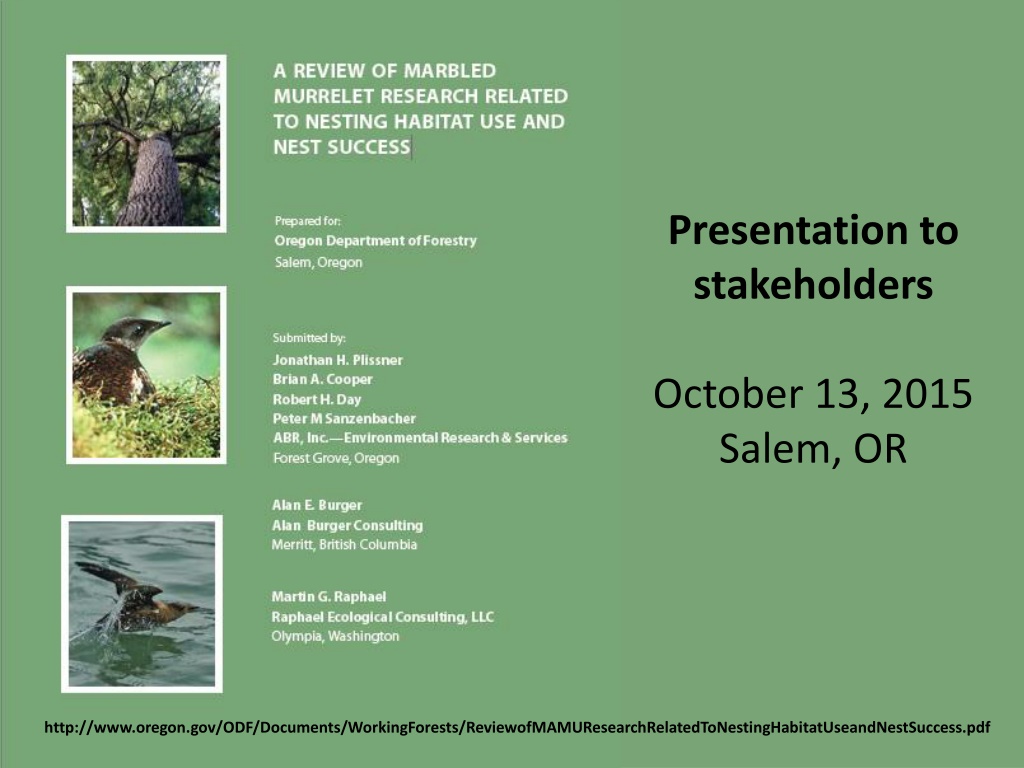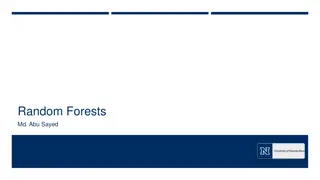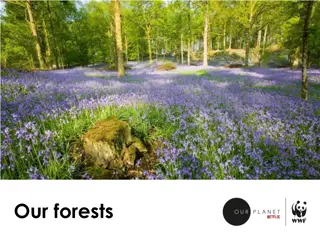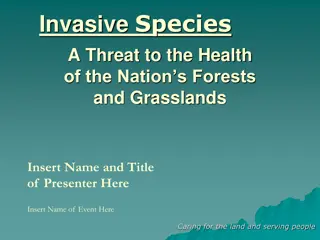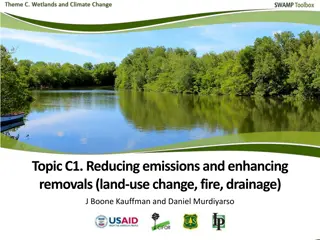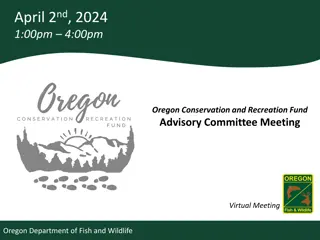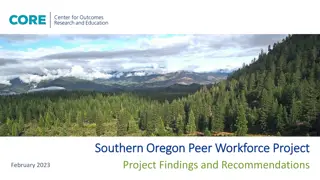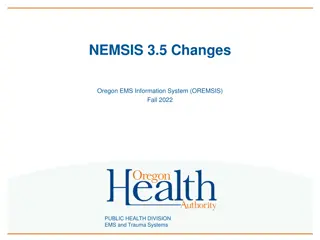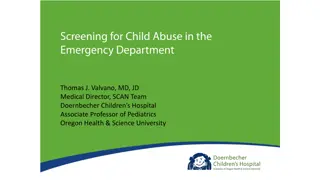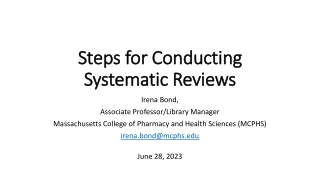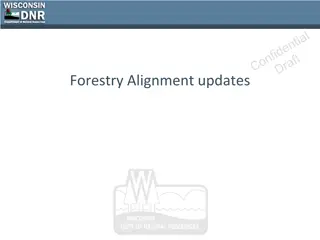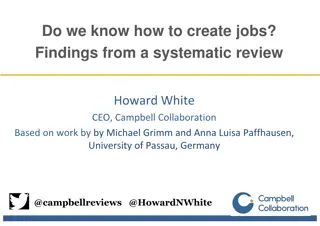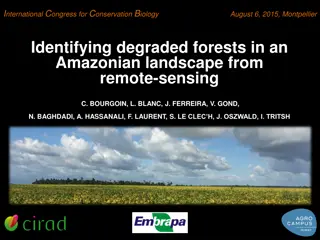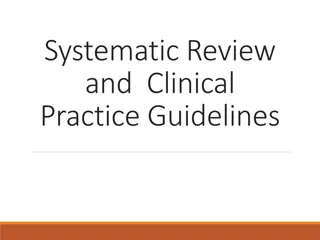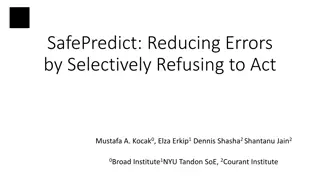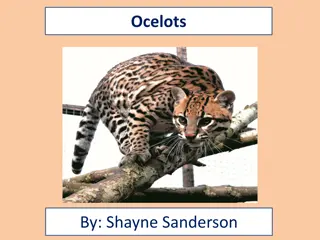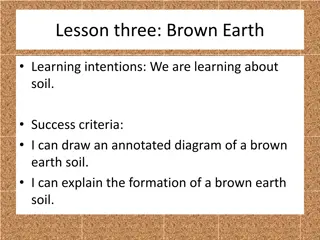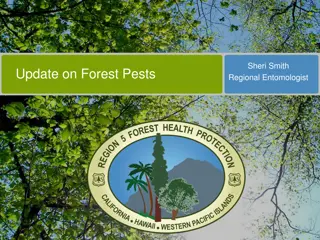Systematic Review of Marbled Murrelet Research in Oregon State Forests
A presentation to stakeholders in Salem, OR, on October 13, 2015, highlighted the systematic review conducted by the State Forests Division on Marbled Murrelet research. The review aimed to assess the science related to key elements of the PSG protocol and other hypotheses. The Division outlined the purpose of the review, including informing survey protocols, policies, and research questions. The historical context of systematic evidence reviews in clinical medicine and conservation was also discussed, emphasizing the importance of structured methodologies for synthesizing and analyzing scientific data.
Download Presentation

Please find below an Image/Link to download the presentation.
The content on the website is provided AS IS for your information and personal use only. It may not be sold, licensed, or shared on other websites without obtaining consent from the author. Download presentation by click this link. If you encounter any issues during the download, it is possible that the publisher has removed the file from their server.
E N D
Presentation Transcript
Presentation to stakeholders October 13, 2015 Salem, OR http://www.oregon.gov/ODF/Documents/WorkingForests/ReviewofMAMUResearchRelatedToNestingHabitatUseandNestSuccess.pdf
Outline Scope of project Systematic reviews Questions Study plan Results Utility of study
Scope November 2013 -- State Forests Division RFP to employ methods similar to those used in Systematic Evidence Reviews , also known as Systematic Review (SR), to assess the amount, strength, and relevance of the science related to several central elements of the PSG protocol and to several other marbled murrelet related hypotheses.
Purpose The Division expects to use the results of the Marbled Murrelet review in the following ways: 1. to inform the ongoing development of and revisions to murrelet survey protocols; 2. to inform longer term Division policies, plans and strategies for murrelet protection; 3. to develop and refine research and monitoring questions; 4. to inform ODF interactions with other agencies, professional organizations, and other interested parties; 5. to further learn about the SR method, and if/how it may be applied to other topics.
Systematic evidence review Historical context 1980 s Clinical medicine 2003 Centre for Evidence Based Conservation (CEBC) & Collaboration for Environmental Evidence (CEE) ODF 2008 pilot project: Does instream wood placement affect salmonid abundance, growth, survival or habitat complexity? (Burnett et. al) 2013: For small & medium streams in the western Pacific Northwest, in or adjacent to forest harvest operations, what are the effects of near-stream forest management on stream temperature and/or riparian shade? (Czarnomski et. al)
Systematic evidence review Elements described in a protocol for conducting a systematic review (Czarnomski and Hale 2013) Elements Question Brief explanation Focused, scientifically answerable question that guides search strategy and inclusion criteria Methods (e.g., search terms and databases) to find studies pertinent to the question Filters used to determine relevance of studies to question Search strategy Inclusion criteria Study quality and relevance assessment Data extraction Criteria used to determine strength of study methodology, and the relevance of study findings to the review question Tables used for consistently recording data and meta-data from studies and associated reviewer notes Methods (quantitative, qualitative) used for synthesizing data with respect to the review question Data synthesis Transparent Objective Repeatable
Study plan Overview: Personnel Questions development Protocol development Search strategy Data extraction Critical appraisal of studies Synthesis
Study plan - Personnel ODF Terry Frueh, Rosemary Mannix, Nick Palazzotto Primary Reviewers Brian Cooper, Peter Sanzenbacher, Robert Day, Jonathan Plissner External Reviewers Martin Raphael, Alan Burger Stakeholders Support
Review Process Stakeholders Questions Study Plan Study Inclusion Draft Synthesis Co-authors ODF
Questions Development of questions Narrow focus 4 questions pertain to elements of ISP 1 question informs management decisions Discussion and review process
Question 1 How are individual behaviors (subcanopy flight, circling, landing, vocalizations) of Marbled Murrelets indicative of nesting in the forest stand where those behaviors occur? Significance of various Marbled Murrelet behaviors as indicators of nesting. Focus only upon measureable indicators of nesting (not prospecting for nest sites, pair-bonding, roosting, etc.).
Question 2 To what extent do Marbled Murrelets exhibit nest- site fidelity at various spatial scales (i.e., at the scale of a watershed, forest stand, tree, branch, and platform), and how does the spatial extent of continuous potential habitat affect nest-site fidelity? Includes repeated use of a nest site within a year or between years by the same or different individuals. Importance of habitat continuity.
Question 3 How does the spatial extent of continuous potential habitat relate to the co-occurrence (i.e., nesting by multiple pairs) of murrelets in a forest stand and at other spatial scales? Known nest locations only. Importance of habitat continuity.
Question 4 How is the occurrence of Marbled Murrelet nest sites related to the number and size of potential nest platforms and platform-tree density within stands of different age-classes (young, mature, and old growth)? Determine whether platform characteristics of murrelet- occupied habitats vary among stands of different age- classes.
Question 5 How is Marbled Murrelet nesting success affected by habitat characteristics? Inform management decisions in areas where occupied sites are identified. Focuses only on habitat associations with nest success (not habitat associations with the presence of nests). Patch-, stand-, and landscape-level habitat characteristics and abiotic factors describing location of nest in relation to topography and distances from landscape features.
Study plan Protocol development CEE guidelines Available at: http://www.environmentalevidence.org/information-for-authors Internal discussion External review/input Revisions
Study plan Search strategy Key papers ISP(Evans Mack et al. 2003) BNA account (Nelson 1997) Reviews: Ralph et al. 1995, Burger 2002, Raphael et al. 2002, McShane et al. 2004, Piatt et al. 2007, Raphael et al. 2008, USFWS 2009, Raphael et al. 2011 Literature searches Search engines, online databases, governmental and university websites Study Inclusion criteria
Study Inclusion Inclusion criteria Does the study specifically address Marbled Murrelets at inland sites? Does the paper contain primary data or novel analysis of secondary data pertaining to the questions? Does the paper contain sufficient information on methodology and results to assess study quality? Does the study include information on one or more of the following behaviors: circling/arcing flight, flight altitude relative to tree height, wing-whirring, jet sounds, wing-beats, stationary calling? Does the study include information on known nesting or non-nesting habitat when behaviors were observed? Does the study include information on either or both of the following: (1) within- or between-year re-use of nesting cup, limb, tree, patch, site, stand, or watershed; or (2) distance between subsequent nests of a bird or pair? Does the study include information on the known number (1 or >1) or density of nesting pairs within one or more of the following: tree, patch, survey site, stand, watershed? Does the study include information on one or more of the following: (1) nest-platform diameters; (2) nest-platform density (including definition of minimal platform size); (3) platform-tree density (including definition of minimal platform size)? Does the study include information on known nesting sites? Does the study include information on nest success or nest failure? Does the study include information on nest-site habitat characteristics? Question 1 2 3 4 5
Study exclusions Superseded results Non-MAMU Results with insufficient information for appraisal Raw data Studies with uncertainty of nests
Study plan -Data extraction Study citation Primary focus of study Focal species Study location (region/state or province) Study area habitat Study design Sampling design Study methods Study dates and study duration (# of years, days within a year) Sampling intensity Sample sizes Statistical analysis of results Statistical power Document type Behaviors recorded Circling behavior definition Distances of recorded behaviors from nest known? Distances of recorded behaviors from potential nesting habitat? How was nesting determined? Pertinent results, including statistical significance values and measures of variation Location of results within article (e.g., specific tables & figures, text) Potential sources of bias or error Effects modifiers Additional notes
Study plan Critical appraisal Relevance Rating Factors: Study objectives: Was the study designed to address specifically the primary review question? Nest habitat: How similar is the nesting habitat (i.e., forest structure and composition) to that found in Oregon? Continuous habitat: Are blocks of continuous habitat defined within the study area? (Questions 2 and 3 only). Nests: Does the study include data on real or artificial Marbled Murrelet nests? (applies to Question 5 only).
Study plan Critical appraisal Confidence Rating Factors: Study design Sampling design Study methods Appropriate statistics Statistical power Study duration Sample size Spatial coverage Document type
Study plan Critical appraisal Study evaluation scoring table (% of maximum possible) Relevance Confidence Study Evaluation Score Study duration (yrs) 3 3 0 3 1 3 3 1 Continuous habitat 2 0 0 2 3 0 0 2 Statistically robust 1 1 1 1 1 1 1 1 Statistical power 1 1 1 1 1 1 1 1 Study objectives 0 0 0 2 2 2 0 0 Sampling design 0 0 1 1 1 3 1 0 Spatial coverage 2 1 1 1 1 2 1 3 Study methods 4 0 4 4 4 4 4 4 Document type 0 2 2 2 2 0 0 2 Study duration Study design 0 0 0 3 3 3 0 0 Nest habitat 1 2 1 1 1 2 1 1 Sample size 1 1 1 5 3 5 3 3 (season) 1 1 2 2 2 2 2 2 Study Burger 1994 Carter and Sealy 1987 Kuletz et al. 1995 Manley 1999 Naslund et al. 1995 Nelson and Wilson 2002 Suddjian 2003 Waterhouse et al. 2011 16 (38%) 12 (29%) 14 (33%) 28 (67%) 25 (60%) 28 (67%) 17 (40%) 20 (48%) Maximum scores 2 2 3 3 4 4 5 4 3 2 5 3 2 42
Study plan Synthesis Each narrative documents an organized, qualitative evaluation of the strength of the entire body of evidence based on the following criteria: (1) Quality: the aggregate quality of the entire body of evidence (based on an average of the Study Evaluation Scores of all the individual studies); (2) Quantity: the number of studies, sample sizes, power, and magnitudes of effect; (3) Consistency: the extent to which similar findings are reported when using similar and different study designs; (4) Coherence: do the findings of the body of evidence make sense as a whole?
Study plan Synthesis Summary of studies Narrative synthesis of results Variation among studies and Effects Modifiers Comparisons with other reviews Conclusions Data gaps
Results Summary of studies 864 PAPERS REVIEWED 71 STUDIES INCLUDED Question 1. 16 studies Question 2. 23 studies Question 3. 14 studies Question 4. 25 studies Question 5. 40 studies 20 additional studies excluded because superseded
Results QUESTION 1. How are individual behaviors (subcanopy flight, circling, landing, vocalizations) of marbled murrelets indicative of nesting in the forest stand where those behaviors occur?
Question 1 Studies 16 studies with primary data or analyses. 15 studies at known nest locations 1 study at sites lacking potential nest habitat 0 studies at sites with potential habitat and confirmed absence of nests Mean study evaluation score: 17.9/39 (46%) Descriptive studies, small sample sizes
Question 1 Dechesne & Smith 1997 Hamer & Cummins 1990 Jones 2001 Lougheed et al. 1998 Manley & Kelson 1995 Manley 1999 Naslund 1993 Nelson & Hardin 1993 Nelson & Peck 1995 Nelson & Wilson 2002 Nelson et al. 1994 Singer et al. 1991 Singer et al. 1995 Suddjian 2003 Varoujean et al. 1989 Witt 1998
Question 1 Study Evaluation Scores
Question 1 Conclusions Subcanopy flights, landings, stationary vocalizations, and circling regularly occur in the vicinity of known Marbled Murrelet nest sites. Most occur at active and inactive nest sites. No studies at sites with potential habitat and confirmed absence of nests.
Question 1 Data gaps Information on behaviors at non-nesting sites, especially those with potential habitat. Information on distance from nests at which behaviors occur. Frequency of occurrence of occupied behaviors at known nest sites and their associations with past, current, and future nesting activity at the site.
Results QUESTION 2. To what extent do Marbled Murrelets exhibit nest-site fidelity at various spatial scales (i.e., at the scale of a watershed, forest stand, tree, branch, and platform), and how does the spatial extent of continuous potential habitat affect nest-site fidelity? Photo by M. Hobson
Question 2 Studies 23 studies with primary data or analyses. Mean study evaluation score: 16.6/42 (40%) Descriptive or anecdotal studies, small sample sizes
Question 2 Barbaree et al. 2014 Bloxton & Raphael 2009 Burger 1994 Burger et al. 2000 Burger et al. 2009 Conroy et al. 2002 Divoky & Horton 1995 Drever et al. 1998 Golightly & Schneider 2011 H bert & Golightly 2006 H bert et al. 2003 Hirsch et al. 1981 Jones 2001 Lougheed et al. 1998 Manley 1999 Manley 2003 Meekins & Hamer 1999 Naslund et al. 1995 Nelson & Peck 1995 Nelson & Wilson 2002 Ryder et al. 2012 Singer et al. 1995 Spickler & Sillett 1998
Question 2 Study Evaluation Scores
Question 2 Conclusions Marbled murrelets frequently re-occupy nesting sites (at a variety of scales) previously used by the same and/or other birds. Fidelity at the scale of the tree and branch may be lower in areas with more continuous habitat, but data too limited to identify the spatial extent of fidelity for individual birds within contiguous habitat at larger spatial scales.
Question 2 Data gaps Relationships between breeding fidelity and the extent of continuous habitat (size of stands/patches). Information on marked individuals to determine individual fidelity and sex differences.
Results QUESTION 3. How does the spatial extent of continuous potential habitat relate to the co-occurrence (i.e., nesting by multiple pairs) of murrelets in a forest stand and at other spatial scales?
Question 3 Studies 14 studies with primary data or analyses. 6 studies identified areas of continuous habitat around nest sites 1 study quantified the habitat area Mean study evaluation score: 19.2/42 (46%) Descriptive or anecdotal studies
Question 3 Bloxton & Raphael 2009 Burger 1994 Carter & Sealy 1987 Hamer & Cummins 1990 Hull et al. 2001 Kuletz et al. 1995 Manley 1999 Naslund et al. 1995 Nelson & Peck 1995 Nelson & Wilson 2002 Ryder et al. 2012 Suddjian 2003 Waterhouse et al. 2011 Zharikov et al. 2007
Question 3 Study Evaluation Scores
Question 3 Conclusions Evidence for co-occurrence of nesting murrelets at the scale of the watershed and forest stand. No studies comprehensively surveyed an entire stand or watershed for nests minimal frequencies of co-occurrence unknown relationship between the extent of habitat and the probability of co-occurrence/breeding density within stands or watersheds
Question 3 Data gaps Intensive tree-climbing efforts to locate all active nests within large sampling areas of contiguous and non-contiguous habitat. Density of concurrently active nests. Quantification of the extent of continuous habitat at watershed and forest stand scales in areas with co-occurrence. Relationship between nest density and habitat area.
Results QUESTION 4. How is the occurrence of Marbled Murrelet nest sites related to the number and size of potential nest platforms and platform- tree density within stands of different age- classes (young, mature, and old growth)? Photo by K. Jordan
Question 4 Studies 25 studies with primary data or analyses. 11 studies omitted because information superseded by analyses of Hamer and Nelson (1995) or Baker et al. (2006) 0 studies provide information on stand age Mean study evaluation score: 22.3/36 (62%) Descriptive or anecdotal studies
Question 4 Baker et al. 2006 Bradley & Cooke 2001 Burger 1994 Burger & Bahn 2001 Burger et al. 2000 Conroy et al. 2002 Dechesne & Smith 1997 Ford & Brown 1995 Golightly & Schneider 2009 Golightly et al. 2009 Grenier & Nelson 1995 Hamer & Nelson 1995 Jordan et al. 1997 Manley 1999 Manley 2003 Manley et al. 2001 Meekins and Hamer 1999 Naslund et al. 1995 Nelson & Wilson 2002 Quinlan & Hughes 1990 Silvergieter & Lank 2011a Silvergieter & Lank 2011b Waterhouse et al. 2007 Waterhouse et al. 2009 Witt 1998
Question 4 Study Evaluation Scores
Question 4 Conclusions Variability in methods and platform definitions limit comparability of platform characteristics across studies Minimal and mean nest limb diameters across all studies were 7 and 26 cm (measured at the bole) and 10 and 28 cm (measured at the nest). Most studies indicated that nest trees typically contained more potential nesting platforms than non- nest or randomly selected trees. Evidence for the density of trees containing potential nest platforms as a predictor of nesting probability is equivocal.
Question 4 Data gaps Data from nests found since 2003. Variability associated with stand age-classes and elevation.
